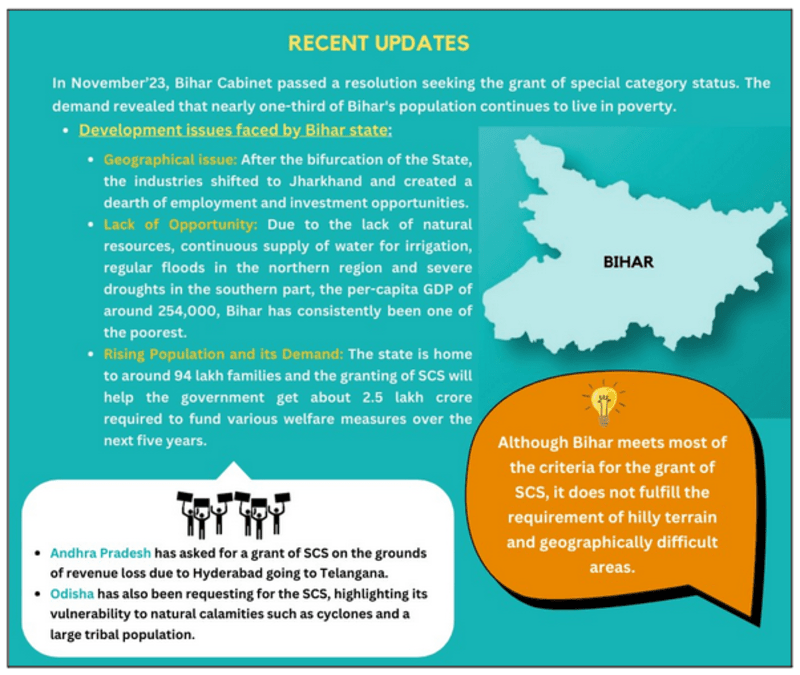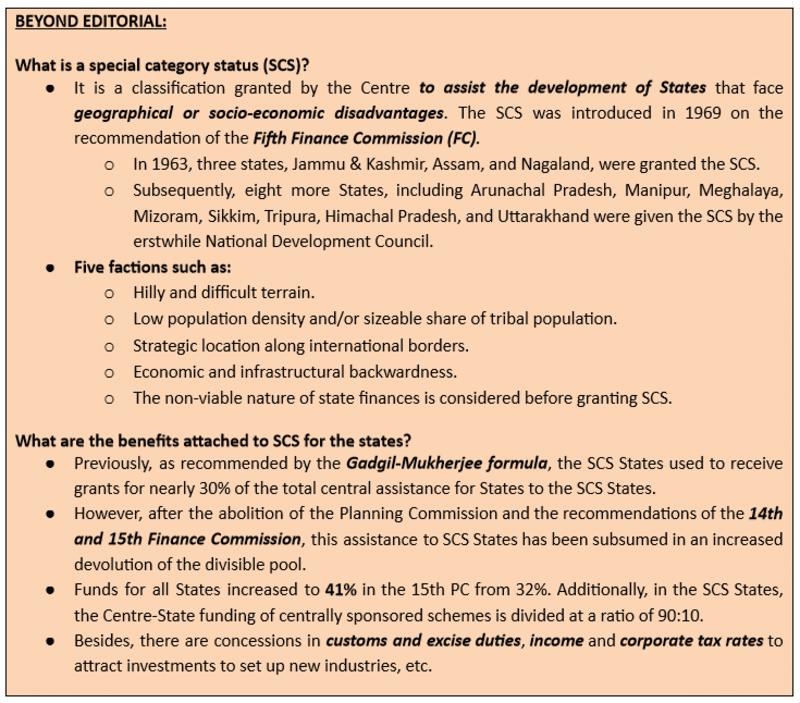Development distances among states should drive reforms
“A Nation will not survive morally or economically when so few have so much and so many have so little” - Brunei Sanders.
Relevance: GS I and III (Social Issues and Economy)
- Prelims: Kuznets Curve; Special Category Status (SCS) and its criteria; recommendations of the 14th and 15th Finance Commission;
- Mains: Inclusive development; Regional disparities; Policy and Administrative issues;
Why in the News?
The larger inter-state disparities and rising development gaps among the states present major challenges for inclusive growth to achieve the aspirational goal 2050.
Background of the News:
- The 1991 structural reforms, designed to transform India's economic policy framework from a highly deregistered system to a more liberalised, market-oriented system, mainly addressed the policy and regulatory framework at the national level but failed for the states.
- For example, the per capita income in Goa is seven times higher than in Bihar.
- Compared to European and other Western countries, there are large differences in levels of development across Indian states.
- Hence, the next phase of reforms must be directed at the states' reforms. Even if we exclude small states like Goa and Delhi, huge gaps remain; Haryana's per capita income is five times that of Bihar.
The issue of large inter-state differences in socio-economic development levels:
- Inadequate measures of development: Per capita income by itself is an inadequate measure of development, but similar large inter-state differences are seen in levels of social development and infrastructure services as follows:
- Disparity in life expectancy: At 75 years, Kerala's life expectancy is ten years longer than 65 years in Uttar Pradesh (UP).
- Disparity in education:
- Most states have primary-level enrolment rates of 90-100%, but large differences appear at higher levels.
- Higher education enrolment is over 51% in Tamil Nadu, compared to less than 15% in Bihar.
- Disparity in other infrastructures: Power consumption in Gujarat is seven times higher than in Bihar, while road density (state highways and district roads) is seven times higher in Kerala than in Jharkhand.
What are the challenges posed by inclusive socio-economic development?
- Huge Development Gaps: To achieve the aspirational goal of becoming a developed country by 2050, the primary challenge is to cover the huge distance that some of the states have to travel, especially the states like Bihar, Jharkhand, Madhya Pradesh, Chhattisgarh, Rajasthan, UP, and Uttarakhand.
- These large differences are also challenging because the states diverge, not converge.
- Demographic and Regionalism Issue: The Southern and Western states of Tamil Nadu, Karnataka, Kerala, Andhra Pradesh, Telangana, Maharashtra, and Gujarat generally pull away from the other less-developed states.
- On the other hand, these less-developed states remain demographically dominant (India's 40% population).
- Growing of geographical cleavage: The larger populated states translate politically into a large share of Members of Parliament (MP) in the Lok Sabha.
- This growing geographic cleavage between economic power and political heft may worsen after the expected delimitation exercise. It will likely make India's politics even more fractious than it already is.

What are the opportunities with large inter-state differences?
- Application of robust mechanism: It is a long-established tradition in development economics to test theories and identify robust regularities in development processes. (Kuznets Curve).

-
- Multilateral development institutions often advise less developed countries on strengthening policies, processes, and institutions based on the "best practices' observed in more developed countries.
- Legacy or ecosystem differences may arise with this approach (International context) however, the states within the country have a shared historical legacy, the same administrative and judicial system, the same tax system, and a common market. These can provide a much more robust basis for learning development lessons.
- Need for prioritised reforms in some states: A state leading in some sectors or services may lag behind in others. Reforms need to be emphasised on the lessons learned and prioritised not in some overarching sense but at the individual level of sectors or services.
- For example, Gujarat is a leading state in power supply, other infrastructure, and industrial development, but it lags on social development.
- Similarly, Maharashtra, a leading state in life expectancy and road density, lags in power consumption and per capita government spending.
- Need for Uniform reforms in all states: In some critical areas like education, health, and infrastructure, all states should aspire to catch up with the best, beyond that, the principle of comparative advantage should apply, and every state should leverage its relative strengths compared to others.
Conclusion:
Large development differences across Indian states pose challenges as well as opportunities. The opportunities can be leveraged to overcome the challenges. But whether state-level political leaders have the necessary vision and humility to learn reform lessons from other states is a key question.

Mains PYQs
Q. Explain intra-generational and inter-generational issues of equity from the perspective of inclusive growth and sustainable development. (UPSC 2020)
Q. Mention core strategies for the transformation of aspirational districts in India and explain the nature of convergence, collaboration and competition for its success. (UPSC 2018)
Q. Many State Governments further bifurcate geographical administrative areas like Districts and Talukas for better governance. In light of the above, can it also be justified that more number of smaller States would bring in effective governance at State level? Discuss. (UPSC 2013)
Prelims PYQs
Q. In a given year in India, official poverty lines are higher in some States than in others because (UPSC 2019)
(a) Poverty rates vary from State to State
(b) Price levels vary from State to State
(c) Gross State Product varies from State to State
(d) Quality of public distribution varies from State to State.


